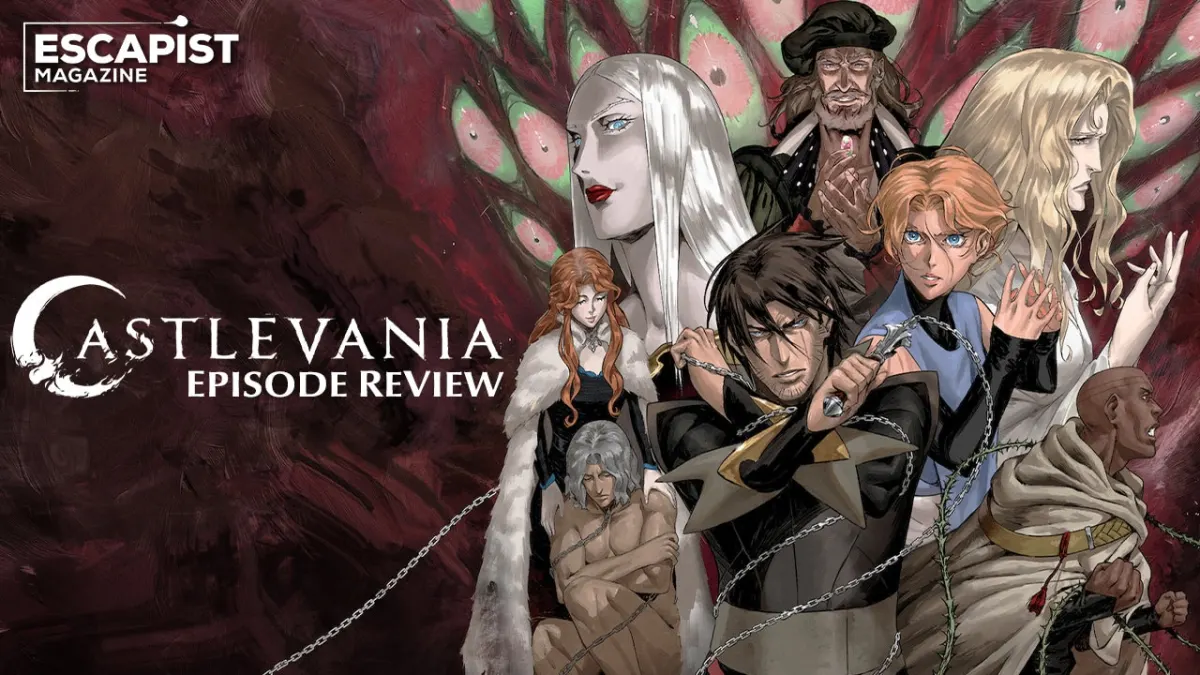The following review contains spoilers for Castlevania season 3, episode 6, “The Good Dream.”
One of the benefits of taking it slow with a series like Castlevania is that it allows me to really parse and dissect what works in the show and why. As much as I love Castlevania, I will admit that it’s not a perfect show, but “The Good Dream” is, without a doubt, the series’s strongest episode to date. But why is that?
Sure, there’s no graphic violence on display here, which is normally one of Castlevania’s hallmarks, but the series has also been equally good at mining characters for their tragedy. Nearly every main character has some tragic quality that the show takes time to explore. There are no cartoonishly one-note characters on display here. Even Dracula, for all of his charisma when he fought our heroes at the end of last season and is usually depicted as a mustache-twirling maniac in the video games, was a broken man devastated by the loss of his wife.
Saint Germain (Bill Nighy) seems to be cut from the same cloth, as he dreams about when he lost his partner in the Infinite Corridor. If the last episode implied that the Infinite Corridor could lead to Shankar’s “Bootleg Multiverse,” then “The Good Dream” cements that fact. The whole sequence of Saint Germain trying to find his partner felt like it was ripped straight out of 2001: A Space Odyssey with surreal light and even more strange images. Giant mechs that have never been seen in the Castlevania franchise appear, and we get a brief glimpse of Germain’s partner, who seems to be in a futuristic and chaotic universe that reminded me of the Chaotic Realm from Aria of Sorrow. Or maybe it’s another series entirely and this mysterious woman will become an important player in some other show.

The important takeaway is that Saint Germain and Dracula are almost kindred spirits. Both men lost the love of their life, though they took their death/disappearance in completely different directions. Dracula took some of his wife’s lessons to heart, like refusing to feed on humans, but still wished for the world to burn in a rage-fueled vendetta. Germain has no such animosity towards the world and instead strives to do what he can to save her. It helps that she’s not officially dead, though the process of finding a portal to the Corridor is far from easy, and Germain looks forward to finally reuniting with his partner.
But we also get a wonderful dose of philosophy with Isaac (Adetokumboh M’Cormack) as he takes a rest in the desert with his army of monsters, striking up a conversation with one of them who still retains the ability to speak. Isaac and the monster speak about how good and evil are almost arbitrary and it’s easy for groups of people to call something sinful if it’s different. The monster was originally a philosopher who was put on trial for his views and was killed despite lying to save himself. The evils of the world turned the honest philosopher, only in pursuit of knowledge, into the monster they made him out to be. Once he was tainted, he discovered that he liked the sin and looks forward to reveling in it now that he’s been unleashed upon the world again.
The scene is captivating to watch and couldn’t have been done better. As the scene slowly continues, we see the monsters around Isaac start to get excited at the story of the fly monster, almost in agreement. Were they all humans who became sinners and thus were turned into monsters? Were they all originally horrible human beings that are just excited to be back for a second round? Whatever the case, Isaac seems to realize that he’s surrounded himself with the worst of humanity, almost vindicating his quest. The monsters surrounding him function as both proof that humans are literally monsters and vindication that if humans could turn normal civilians into monsters, then they don’t deserve to exist.
Dreams serve as a running motif in both sections and motivate these characters into action. Germain views his dreams as a reminder of his foolishness and how he needs to fix the wrongs he made, while the fly monster, and presumably all of Isaac’s monsters, views its dreams as justification in the quest for vengeance. The final plot of the episode focuses on Hector (Theo James) finally being allowed to walk out of his cell with Lenore (Jessica Brown Findlay), fittingly giving us a look at what Hector’s dream is for this season: freedom.
Hector being allowed to finally go outside — but wearing a dog collar — seems unfortunately fitting to him. He’s never shown independence and has instead relegated himself to serving his various masters, whether Dracula or, as it most likely will be by the end of the season, Lenore. If she were to provide the illusion of freedom while still binding him, it would fit Hector’s character perfectly, and come season’s end, it’ll be interesting to see just how free he actually is.
“The Good Dream” was a marvelous Castlevania episode that was thematically rich and well structured. A little detail I enjoyed was that each plot appeared to have taken place around the same time, in the dead of night, separate in location but not in theming. Germain, the fly monster, and Hector were all able to share their dreams and see just how their unconscious desires will shape their behavior moving forward. It was a well-deserved breather from all of the forward momentum, yet that didn’t stop it from being engrossing and almost poetic at times.






Published: Mar 17, 2020 05:48 pm